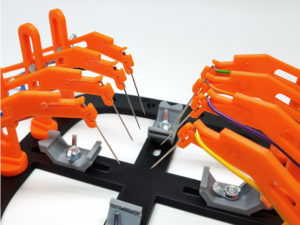 One Italian police officer is very no-nonsense about his job—as many are—but he’s even more so as a maker. Searching for greater efficiency while working in the lab, Giuseppe Finizia has created a new iteration of his PCB workstation, putting the power of 3D printing further to work. We followed his original project a couple of years ago, as he brought forth a PCB workstation with articulated arms, all in an attempt (quite a successful one) to perform technical assessments more fluidly.
One Italian police officer is very no-nonsense about his job—as many are—but he’s even more so as a maker. Searching for greater efficiency while working in the lab, Giuseppe Finizia has created a new iteration of his PCB workstation, putting the power of 3D printing further to work. We followed his original project a couple of years ago, as he brought forth a PCB workstation with articulated arms, all in an attempt (quite a successful one) to perform technical assessments more fluidly.
Finizia works in the Scientific Investigations Department of the Carabinieri—Italian military police—and spends most of his time in the electronics library. For his original work, he used the MoI 3D to make the 3D printed parts. Fast forward a couple of years and he is now using a Zortrax M200 to create and refine his innovations.
“In this new design, I have swapped out the Hirschmann spring loaded test probes that were used in the previous model for standard sewing needles, which has drastically reduced the cost of parts for the PCB workstation,” Finizia told 3DPrint.com. “Moreover, I have added an elastic pressure mechanism to each crane arm, which adequately ensures the connection between the tip of the needle and the circuit board. The 3D printed crane arms have been modified to be thinner and less bulky, which frees up considerable workspace space for user.
“Finally, the new version’s base frame is compatible with various types of articulated arms and accessories, including the ones that were designed for the first PCB workstation.”
Featured on Thingiverse, this new project is clearly an ‘evolution’ of his previous work, with the following new features:
- Less expensive probes. Finizia has now been able to 3D print cheaper sewing needles that also allow for ‘very precise connections.’
- Use of numerous accessories from Finizia’s first piece of work, with the frame being able to use multiple articulated arms at the same time, whether of crane or ball and socket type.
- Less cumbersome crane arms. Compared to the previous workstation, they allow more space for the user to work.
 Users who are interested in such a workstation can check out the design and instructions on Thingiverse should they wish to 3D print their own. Post-printing procedures are listed as well and are fairly simple, including advice on how to mount the bumpers for more stability, and then begin assembling the PCB holders and articulated arms. Finizia recommends a couple of different needle sizes that can be used, along with additional parts and accessories such as a magnifying glass, LED lamp, or more. Finizia suggests checking out his previous edition for more accessory ideas. Discuss in the 3D Printed Workstation forum at 3DPB.com.
Users who are interested in such a workstation can check out the design and instructions on Thingiverse should they wish to 3D print their own. Post-printing procedures are listed as well and are fairly simple, including advice on how to mount the bumpers for more stability, and then begin assembling the PCB holders and articulated arms. Finizia recommends a couple of different needle sizes that can be used, along with additional parts and accessories such as a magnifying glass, LED lamp, or more. Finizia suggests checking out his previous edition for more accessory ideas. Discuss in the 3D Printed Workstation forum at 3DPB.com.
Subscribe to Our Email Newsletter
Stay up-to-date on all the latest news from the 3D printing industry and receive information and offers from third party vendors.
Print Services
Upload your 3D Models and get them printed quickly and efficiently.
You May Also Like
3D Printing News Briefs, July 2, 2025: Copper Alloys, Defense Manufacturing, & More
We’re starting off with metals in today’s 3D Printing News Briefs, as Farsoon has unveiled a large-scale AM solution for copper alloys, and Meltio used its wire-laser metal solution to...
Etsy Design Rule Change Reduces Selection of 3D Printed Goods
Online marketplace Etsy has implemented a rule change requiring all 3D printed goods on the site to be original designs. The update to the site’s Creativity Standards states, ¨Items produced using...
Siraya Tech Introduces New Elastomer 3D Printing Materials, Including Foaming TPU
California company Siraya Tech, founded in 2019 with a focus on material science, customer focus, and agility, develops high-quality 3D printing materials that meet the needs of creators, hobbyists, and...
3D Printing News Briefs, April 12, 2025: RAPID Roundup
The news from last week’s RAPID+TCT in Detroit just keeps on coming! That’s why today’s 3D Printing News Briefs is another RAPID Roundup of more exciting announcements from the trade...



































